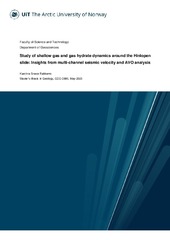| dc.description.abstract | The Hinlopen submarine slide located on the northern Svalbard margin is one of the largest submarine slides documented to date. The cause of the slide is associated with destabilizing factors like glacio-tectonic activity, isostacy, gas accumulation, gas hydrate dynamics, and rapid sediment loading in interglacial periods. Free gas accumulation within continental slope sediments is one of the most important factors affecting sediment stability, it can lead to increase in pore pressure and cause overpressured conditions. Accumulation of shallow gas is highly related to the melting of gas hydrates, which can be caused by e.g. glacial isostatic rebound or sea level change. Mapping gas hydrates and shallow gas accumulation in sediments is therefore important in geohazard settings. The main objectives for this project is to establish an efficient seismic processing flow for marine multichannel seismic data, and investigate the potential link between shallow gas, gas hydrates, glacial dynamics and submarine slope stability around the Hinlopen slide, while also conducting an investigation into several seismic anomalies located in the Sophia Basin, where recent academic questions regarding the origin of the anomalies have been raised.
Seismic interpretation and velocity analysis on 2D multi-channel seismic data located north of the Hinlopen slide revealed numerous shallow fluid indicators such as high amplitudes coinciding with low velocity zones, possible migration pathways and gas hydrate presence. On the slope leading out to the slide’s run-out area, base gas hydrate stability zone estimations suggest a gas hydrate composition of methane/propane in fresh- or saltwater conditions on the mid- to lower part of the slope, but a composition of pure methane in freshwater conditions on the upper slope, suggesting gas hydrates formed during a period where glacial meltwater may have saturated the sediments. AVO analysis within the FGZ identified anomalous behaviour suggesting gas presence, and indication of possibly overpressure conditions. In contrast AVO analysis in the GHSZ within the same reflection showed little to no anomalous behaviour. Observations and results largely correspond to similar studies and supports the accepted hypothesis for the area.
Seismic interpretation and velocity analysis of 2D multi-channel data west of the slide area also exhibited several fluid indicators like migration pathways and amplitude anomalies coinciding with low velocity zones. Though it also revealed high seismic anomalies overlying high velocity zones, indicating what is interpreted as a possible basaltic presence. | |


 English
English norsk
norsk
